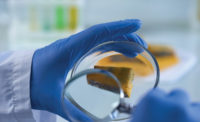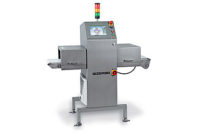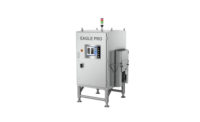Case Study
Cost of product inspection machinery in dairy operations is justified
Wipotec found that processors reap savings when purchasing inspection equipment.






We’ve all heard the “it pays for itself” sales pitch in one form or another and, understandably, it tends to raise a skeptical eyebrow. It’s an overused cliché uttered by salespeople who have an obvious ulterior motive: selling you stuff.
The sales pitch suffers from a “The Boy Who Cried Wolf” problem: For every 10 times you hear it, it might be true only once — or even never. Manufacturing managers in the dairy segment, who also have to consider the risk of recommending an expensive infrastructure investment, can be forgiven for being hesitant with purchasing decisions. After all, these savvy pros need to be completely sure they are purchasing the most effective and financially sound infrastructure solutions.
Luckily, not all promises of timely return on investment (ROI) are created equal. Let’s look at hard data that show how inspection equipment in the dairy sector can truly pay for itself. The proof is in the pudding — and the cheese and yogurt.
Checkweighing equipment: a saving grace
Let’s start with an entirely uncontroversial statement: Overfilling product costs manufacturers money through waste, while underfilling can cost them money through damaged reputations — a fast track to lost business.
Working collaboratively with dairy customers, Wipotec-OCS Inc. has accumulated a wide swath of production data on diverse packaging lines running packaging ranging from shredded cheese bags to yogurt cups. What it learned was that a little checkweighing goes a long way.
For example, consider a shredded cheese line that typically runs two shifts per day, seven days per week at 150 bags per minute. That’s a healthy annual output north of 35 million bags. The bags are 200 grams each, and the value of the product is placed at $2.23 per kilogram (approximately $1 per pound).
The average overfill per bag in this sampling was 2 grams, which seems negligible until considering the over 700,000 bags of shredded cheese produced each week.
The checkweighing goal was simple: Cut overfill in half. This benchmark was achieved easily because, quite simply, any checkweighing equipment worth buying should have no problem with precision within 1 gram.
The savings? In just a year, $78,674. The checkweigher cost $64,200. The company recovered its infrastructure investment in less than 10 months.
This was no anomaly. The facility of one of Wipotec’s yogurt customers also runs two shifts, seven days per week. At 240 cups per minute, the yogurt company produces more than 56 million cups of yogurt per year. The product was valued at $3.07 per kilogram.
The cups were 150 grams each, and it was discovered that the average overfill rate was 1/2 gram. The goal was to get that down as close to zero as possible. That takes a sophisticated checkweigher but, fortunately, that’s what the customer bought.
Even with such a modest goal — shaving about 1/2 gram off overfills — the company saved more than $43,323 in a year. The $67,600 checkweigher paid for itself in just over 18 months.
Adding X-ray equipment
In dairy, it isn’t just the package’s weight that requires inspecting, but the product itself. Fortunately, X-ray inspection equipment also can be an investment that expediently covers its initial cost.
Consider Wipotec’s aforementioned shredded cheese customer. Using a checkweigher alone, the manufacturer realized an annual savings of $78,674, recouping the $64,200 cost of the checkweigher in well under a year. Combining the checkweigher with a suitable X-ray inspection system brought the company’s total infrastructure investment to $163,000. Here, the ROI can go in one of two directions — either of them satisfactory.
The first scenario is one in which the X-ray inspection module prevents a recall. For the sake of simpler math, let’s say the cost of such a recall would be an even $1,000,000. (This figure is more than generous: Per a 2017 study by the Food Marketing Institute and Grocery Manufacturers Association, this is likely about one-tenth of a contamination-caused recall’s actual costs.)
In this hypothetical instance, the combination checkweigher and X-ray inspection equipment would pay for itself in five days. Even if the recall was prevented six months after its implementation, the cost savings versus the investment figure means the equipment paid for itself in less time than it took to deliver it.
And even if it doesn’t prevent a recall, the combination of a checkweigher and X-ray inspector has far more than a “better safe than sorry” appeal. Even if everything the X-ray equipment scans comes back clean (nice job!), the $78,674 saved via checkweighing means the $163,000 investment is recouped in 24.9 months — just over two years.
For Wipotec’s yogurt customer example, combining a checkweigher with an X-ray scanner makes sense as long as the company has a five-year plan — or, more precisely, a less-than-four-year plan. Given the astronomical cost of a potential recall, this scenario’s ROI is exactly the same as the shredded cheese line: five days. This figure showcases not only how reasonably priced most inspection machinery is, but also how tremendously costly recalls are.
With no recall, the yogurt manufacturer would make back its investment in 45 months — a little less than four years. So basically, at any time leading up to the 45-month mark, the yogurt company is paying for peace of mind. At any point past it, it’s already bought it.
There’s another overused saying: “You can’t put a price on safety.” Sure you can: Today’s sophisticated line tracking systems provide an abundance of metrics that allow dairy manufacturers to do exactly that.
It is entirely possible to determine the price of product quality and waste reduction. This discovery process leads an increasing number of dairy companies to the informed decision that inspection equipment does indeed “pay for itself.”
Looking for a reprint of this article?
From high-res PDFs to custom plaques, order your copy today!









